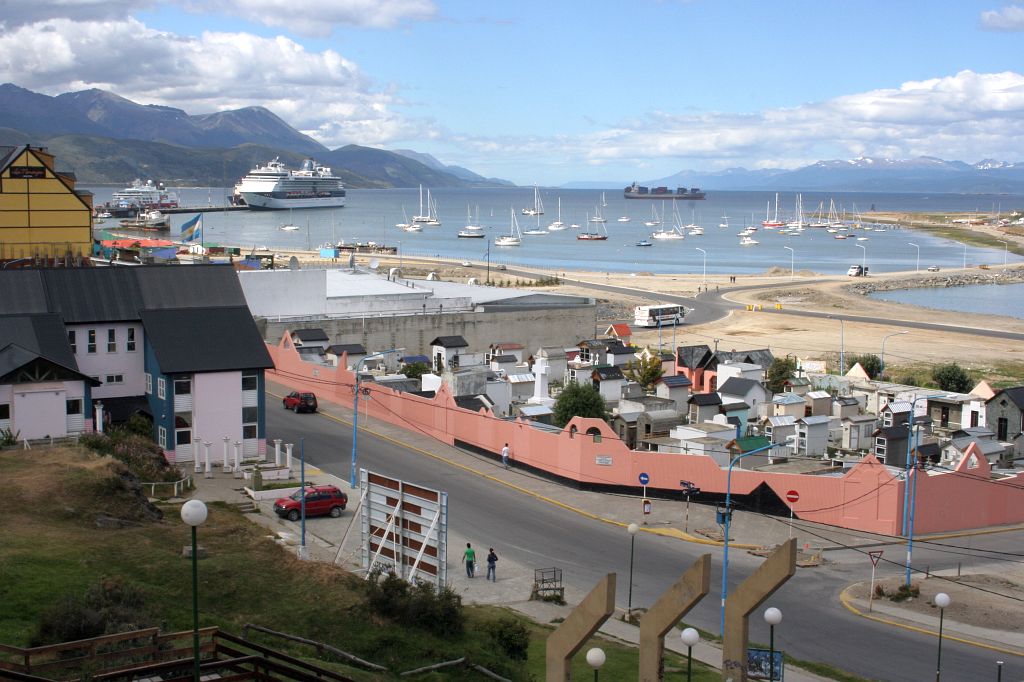I can find good geo-topics practically anywhere. Often I derive inspiration from anonymous Twelve Mile Circle visitors who sprinkle digital trails behind them as they travel along. Every one of us leaves fingerprints behind whenever we tunnel through the Intertubes.
It’s innocuous for the most part. Generally we don’t think much about it as we jump from one site to another. However, it’s all there and it’s all available. I can’t and don’t use any of it to identify individuals (nor do I want to). Even so, I do use it to generate plenty of great story ideas.
One trekker arrived from Ushuaia, Argentina looking for information on New Zealand Ferries. That’s what I believe, anyway. The incoming IP address geolocated to that rare spot. This person thus became the southernmost visitor to my website totally unbeknownst to them. So that’s likely an honor that will extend until someone from Antarctica calls.
Indeed, Very Far South
Ushuaia sits at 54.8° south of the equator. There aren’t many places of significance further south than Ushuaia.
Ping around the Internet for awhile and examine the situation. It won’t take long to find a variety of sources that consider Ushuaia to be the southernmost city in the world. “City” is such a subjective word. Does 60,000 people make it a city? Punta Arenas in Chile has double that population a little further north. Puerto Williams has a couple thousand people a bit further south. Which one is the southernmost city?
Argentina and Chile also have a history of one-upmanship at the continental tip. There they jockey for control of trading routes, tourism and access to Antarctica. I guess Ushuaia has as good a claim to being the southernmost city as the others. Really though, it’s more for bragging rights than anything else.
Why Does It Exist?

In fact the strategic location of Tierra del Fuego and the geopolitical situation with Chile led to the founding of Ushuaia in the first place. It doesn’t have Sixteenth Century roots like many other towns and cities in Argentina, not at all. Rather Ushuaia dates back only to the 1890’s when it started as a penal colony. Those early convicts literally built their own prison and then a town around it.
Ushuaia provided a remote, confined location for the more troublesome members of society. Additionally it let Argentina assert sovereignty over its southernmost domain. That sounds a lot like the Australian model and indeed it took inspiration from that source.
Getting There

Ushuaia gazes upon the Beagle Channel, with Chile to the south and west. It anchors Argentina’s triangular corner on the Island of Tierra del Fuego. Thus, it sits isolated and detached from the rest of the nation.
Airlines and ships provide the most direct access to and from the Argentine mainland. It is also possible to arrive by automobile. However, this journey requires crossing into Chilean territory and taking a ferry across the Strait of Magellan. In theory one should also be able to arrive by bus. That would require several distinct transfers and lots of time so pack some patience.
Trains do not reach this far south. But the city does have an antique 8 kilometre narrow-gauge steam railroad called the End of the World Train (Ferrocarril Austral Fueguino) into the Tierra del Fuego National Park. It serves as a major tourist attraction. Officials designed it originally to carry timber into Ushuaia as the prisoners built the town. Today many consider this the world’s southernmost railroad although it’s self-contained and it has no outlet to the outside world.
Thanks Ushuaia!
I didn’t know anything about Ushuaia until I noticed that small dot on my website access map in Google Analytics. This sounds like another great place to visit. Maybe I should add it to my every-growing list of towns that I someday want to see in person.
Do you know of a peculiar place or location you’d like me to feature on Twelve Mile Circle? Maybe your home town? Please let me know in the comments below or in a separate email message. Don’t let me know why you believe it’s a geo-oddity though. I’ll figure that out on my own and the answer may be completely different than what you expected. Learning is part of the fun.

Leave a Reply